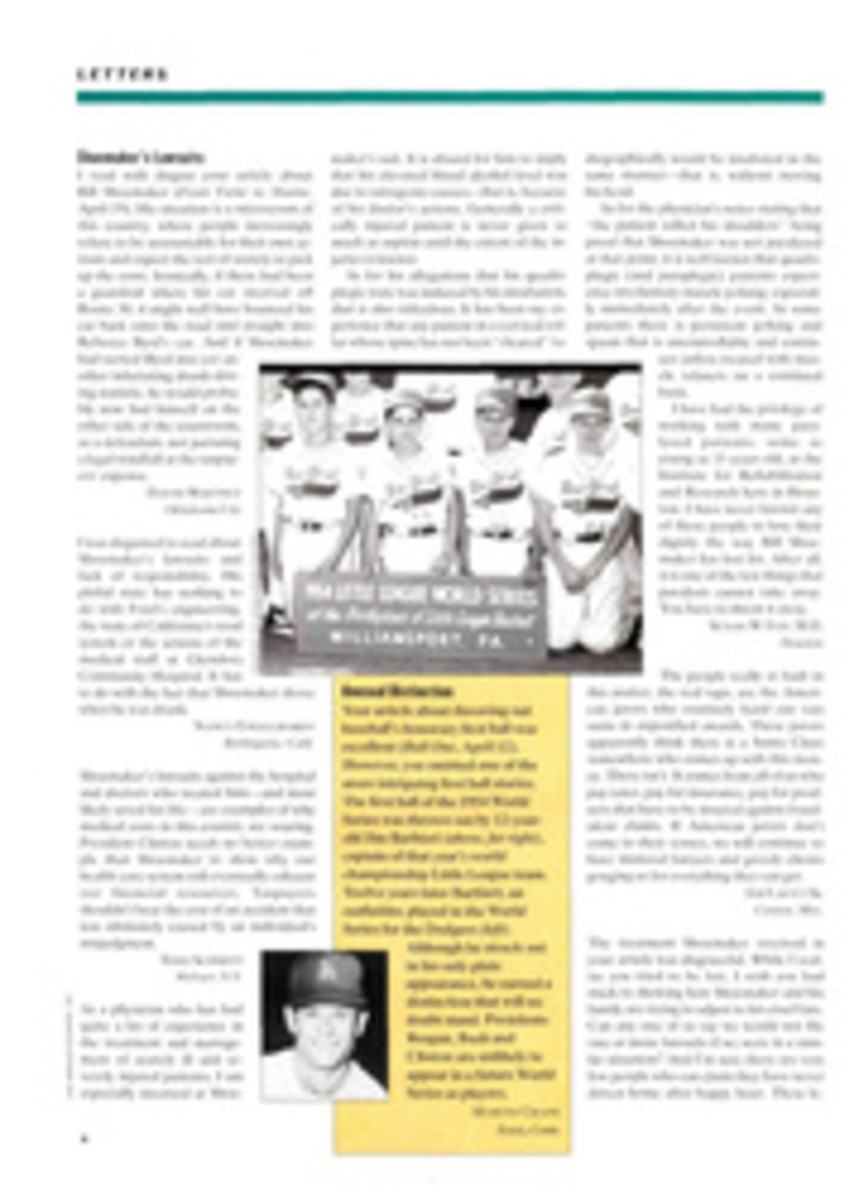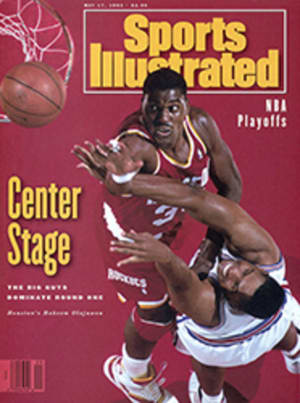
SCORECARD
ABA Milestones
Officially, Julius Erving and Dan Issel, who were inducted on Monday into the Basketball Hall of Fame, are the NBA's 29th and 65th alltime leading scorers, respectively. But they rank that low only because of the league's refusal to include statistics from the American Basketball Association in career totals. Otherwise, Erving and Issel would rank third and fifth on the NBA scoring list, which is headed by Kareem Abdul-Jabbar (38,387 points in 20 NBA seasons) and Wilt Chamberlain, (31,419 in 14 NBA seasons). Erving's total would be 30,026 points (11,662 in five ABA seasons and 18,364 in 11 in the NBA), while Issel, who now coaches the Denver Nuggets, would have 27,482 points (12,823 in six ABA seasons and 14,659 in nine in the NBA).
It's time the NBA followed the lead of the NFL, which includes slats from the American Football League in its career totals. Ending the statistical freeze-out would do justice to former ABA stars like Erving, Issel, George Gervin, Artis Gilmore, Moses Malone and George McGinnis, all of whom went on to excel in the NBA.
Such a gesture would be especially timely since the NBA may be about to say goodbye to Malone, its last survivor from the ABA. The 38-year-old Malone played sparingly this season, his 17th in the NBA, for the Milwaukee Bucks, and the Bucks have bought out his option. Unless another NBA team picks him up, he may play in Europe next season. With 27,066 NBA points, Malone is fourth on the league's alltime list. If ABA totals were counted, Malone, who scored 2,171 points in his two ABA seasons, would leapfrog over Elvin Hayes, who's now No. 3 on the NBA list, with 27,313 points, but would still rank fourth—behind Erving and ahead of Issel.
Fido and Friends
Milk-Bone, the dog-biscuit outfit, has introduced a series of 20 baseball cards, two per box, featuring players and their pooches. Among the subjects: Los Angeles Dodger centerfielder Brett Butler and his miniature dachshunds. Beenie and Cecil; San Francisco Giant first baseman Will Clark and his Labrador retriever, Psycho; and Cleveland Indian pitcher Matt Young and his Dalmatian, Cy. Cy Young, get it?
Sidetracked
After months of fruitless negotiations with dozens of potential sponsors, the New York Road Runners Club announced last week that Reebok had agreed to bankroll the New York Games only hours before the May 22 event was to be scratched. Founded in 1989, the track meet lost its main sponsor last fall when Mita, the copy-machine company, pulled out. Now it will go on at Columbia University's Wien Stadium as scheduled.
Obviously, that's good news. But one wonders how the New York City meet ever got so close to extinction. After all, it's one of only two Grand Prix events in North America—the other is the Bruce Jenner Classic, in San Jose, to be held this year on May 29—and it has consistently drawn such top athletes as Leroy Burrell, Jackie Joyner-Kersee, Roger Kingdom and Carl Lewis. Yet attendance has been disappointing.
But then, track and field is having its troubles generally, especially in New York. Last week USA Track and Field announced that starting next year, the USA/Mobil indoor championship will move to the Georgia Dome, in Atlanta. The indoors have been held in Madison Square Garden almost continuously since 1888, but lately attendance has declined and performances have been hampered by the Garden's narrow, 160-yard board track. The Georgia Dome will offer a state-of-the-art 200-meter track, and it is hoped that the Mobil meet can capitalize on increasing interest in track and field in Atlanta as the 1996 Summer Olympics draw closer.
Counted Out
Besides losing the Mobil meet, Madison Square Garden announced last week that it will dissolve its boxing department by the end of the summer. Garden officials were being slightly disingenuous in putting out the story that the sport was being dropped because the arena's parent company, Paramount Communications, was dismayed by recent, but hardly surprising, allegations of ties between boxing and organized crime. The main reason for the move was financial: With casinos in Las Vegas and Atlantic City staging championship bouts as loss leaders, the Garden couldn't compete for fights in its 19,000-seat main arena, and the lesser cards it has been putting on in its 5,600-seat Paramount theater were struggling.
The decision virtually ends the long association between boxing and its most famous venue. In theory, the Garden could still host cards as a landlord rather than as a promoter, but that isn't likely to happen too often. If the Garden bosses can't make money on prize fights in their own building, how can an outside promoter who has to pay rent be expected to do so?
Counted Out (cont.)
Miami Beach's Fifth Street Gym is no more. The storied boxing sweatshop, which opened in 1951, drew everybody from Kid Gavilan and Roberto Duran to Archie Moore and the Sugar Rays, Robinson and Leonard, but it was Muhammad Ali who was most closely identified with it. SI's Pat Putnam reminisces.
The entrance was a narrow rectangle cut into a concrete block of pale pink. As you climbed the 15 linoleum-covered steps, you came to a sign that read STOP AND PAY FIFTY CENTS, NO DEAD BEATS. Chris Dundee, the promoter who owned the gym, stationed a hard-eyed senior citizen at the door to collect the levy.
Just inside the smoke-filled gym was a blackboard listing in chalk the boxers scheduled to train that day. The names of local stars were painted on, as though their careers would last forever. The solitary ring was seldom empty. Twin heavy bags and two speed bags groaned and chattered, except when Ali sparred and everyone stopped to watch. A large fly-specked mirror rested against a wall, by a door that led to tiny dressing quarters. Inside were dented lockers, a blistered wooden bench and two sorry-looking showers. When the showers clogged, the runoff flooded the drugstore downstairs.
Drawn like prospectors to Sutter's Mill, the big-time writers—Red Smith, Jimmy Cannon, Budd Schulberg—flocked to the gym, usually in the spring, when baseball brought them south. Angelo Dundee, Chris's younger brother and Ali's trainer, would host the visitors at Puerto Saqua, a short stroll north at 7th and Collins. The topic of conversation, boxing, and the lunch of Cuban steak, black beans and rice, and banana pie never varied.
Chris sold the joint in 1981, and it fell into decay, then disuse. The walls, once covered with fight posters and photos, became chipped and bare. Windows were cracked or missing. Eventually the only piece of equipment that worked was a padlock that secured the grill across the entrance. Last week, in an act of mercy, the building was razed, to be replaced by a parking garage or a shopping center.
Different Strokes
If Ben Crenshaw had chosen a paintbrush over a putter, would he have produced a masterpiece rather than a Masters victory? Probably not, but the 49 pro golfers (including Crenshaw, Jack Nicklaus, Greg Norman and Ian Woosnam) and celebrity duffers (ranging from Lawrence Taylor to John Updike) whose self-portraits appear in the June issue of Golf Digest acquitted themselves well with their artwork, which the magazine will auction off for charity. Sandy Lyle sketched himself hitting the shot that won him a green jacket at Augusta in 1988, Pat Bradley outfitted herself in a dress in the shape of the bell her mother rings when Pat wins a tournament, and Nick Price showed himself reeling in a fish representing the PGA Championship he won last year. More self-deprecating is Mark Brooks, who is seen stranded in a cavernous bunker at 27 over par at the U.S. Open. Another portfolio highlight: 80-year-old Sam Snead's portrait of himself eyeing a long putt with a dollar sign above his head.
ILLUSTRATION
Bradley's Bradley
ILLUSTRATION
Snead's Snead
ILLUSTRATION
Brooks's Brooks
PHOTO
JOHN IACONO
PHOTO
FOCUS ON SPORTS
PHOTO
RICH FRISHMAN
They Wrote It
•An editorial in Newsday, complaining that the NHL's 21-game suspension of Washington Capital center Dale Hunter for mugging New York Islander star Pierre Turgeon was too light: "Commissioner Gary Bettman missed a wide-open net."
•Bernie Lincicome in the Chicago Tribune: "This is how weird baseball has become. Fantasy baseball has a real commissioner. Real leagues have a fantasy commissioner."
Little Shavers
Cincinnati Red relief pitcher Jeff Reardon (right, before and after) sponsors a Little League team in Palm Beach Gardens, Fla., on which his son Jay plays. Since joining the cleanly groomed Reds in the off-season, Reardon has been preaching what he is now forced to practice. "I have only one rule," he tells the kids. "No beards."
The Pros' Perspective
Fred Couples, who stands 10th on the 1993 PGA Tour money list, with $392,125 in winnings, has been ordered by a judge in Palm Beach, Fla., to pay his estranged wife, Deborah, $52,000 a month in support. Wags on the Tour noted that the first installment would suffice to rank Deborah 115th on the money list, ahead of, among others, Bruce Lietzke and Curtis Strange.
They Said It
•Lou Piniella, Seattle Mariner manager, making light of his storied temper: "I've always been relaxed as a manager. It's just that I've done things that didn't portray that very well."
•Lincoln Kennedy (right), the 6'6", 342-pound offensive lineman drafted by the Atlanta Falcons, on the difficulty he has buying clothes: "I've got a 20-inch neck and a 40-inch sleeve. You just don't walk into a store and say, 'Uh, let me have a shirt in 20-40, please.' "

